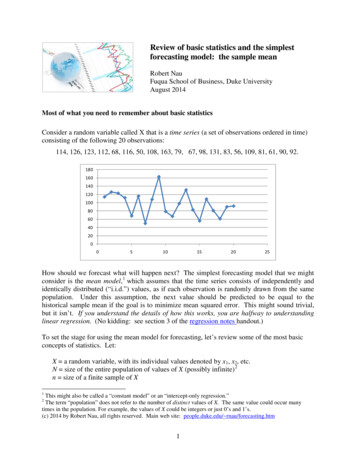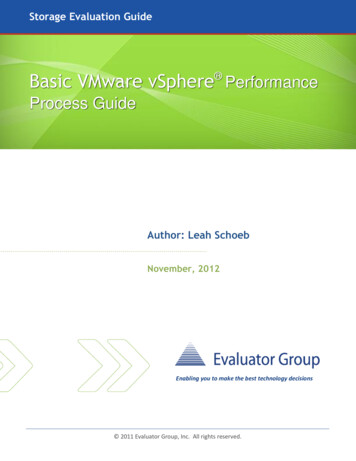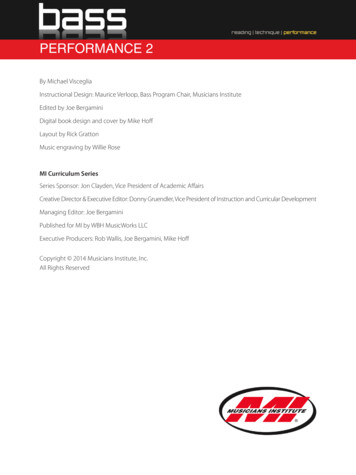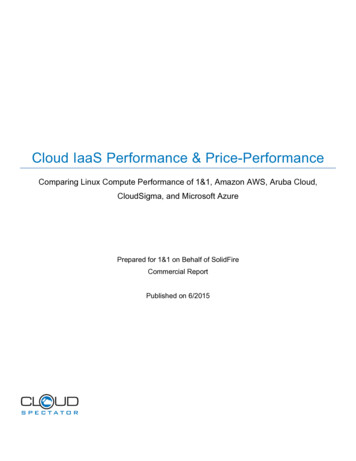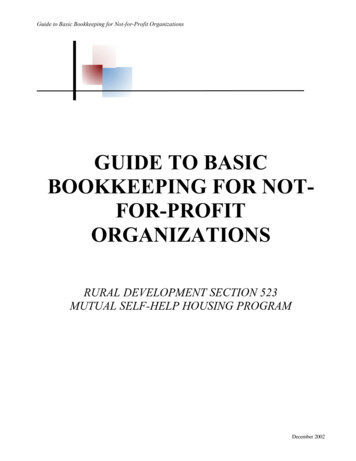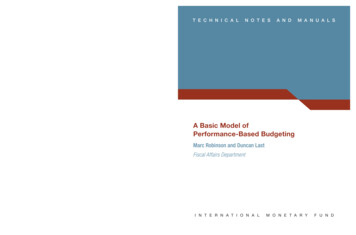
Transcription
T e c h n i c a lN o t e sa n dM a n u a l sA Basic Model ofPerformance-Based BudgetingMarc Robinson and Duncan LastFiscal Affairs DepartmentTNM/09/01International Monetary FundFiscal Affairs Department700 19th Street NWWashington, DC 20431USATel: 1-202-623-8554Fax: 1-202-623-6073I nt e r nati o na lM o n e ta r yF und
INTERNATIONAL MONETARY FUNDFiscal Affairs DepartmentA Basic Model of Performance-Based BudgetingPrepared by Marc Robinson and Duncan LastAuthorized for distribution by Carlo CottarelliSeptember 2009DISCLAIMER: The views expressed in this technical note are those of the authors andshould not be attributed to the IMF, its Executive Board, or its management.JEL Classification Numbers:D61, D73, H61, H83Keywords:performance budgeting, expenditure prioritization, managing-for-results,program budgeting, expenditure review, program classificationAuthor’s E-mail Address:marc@pfmresults.com; dlast@imf.org
T E C H N I C A L N o te s an d M A N U A L sA Basic Model of Performance-Based BudgetingMarc Robinson and Duncan LastThis technical note addresses the following main questions: What are the characteristics of a basic model of performance-based budgeting? How should low-income countries approach performance-based budgeting? What preconditions should exist before starting? What forms of performance-based budgeting should low income countries avoid?I. Objectives of the Note*The primary objective of this technical note is to elaborate a basic model of performancebased budgeting that could be considered for the following two categories of countries: those that wish to introduce a performance-based budgeting system while minimizing thecomplexities and costs of doing so; and those with limited resources and capacity, including appropriate low-income countries (LICs).The note emphasizes necessary preconditions for any move to performance-based budgeting—recognizing that performance-based budgeting, even in its basic form, should not be consideredin countries with seriously dysfunctional public financial management (PFM) and governancesystems.More complex performance-based budgeting models exist. This note describes these, andoutlines reasons why these models of performance-based budgeting may not be appropriate inmany countries.* An earlier version of this note was previously issued as part of a series of technical notes on the IMF’s Public FinancialManagement Blog (http://blog-pfm.imf.org).Marc Robinson was a Senior Economist in the Fiscal Affairs Department of the International Monetary Fund; Duncan Last isa Senior Economist in the Fiscal Affairs Department.The sequencing or implementation planning for introducing a performance-based budgeting approach is not discussed here.Technical Notes and Manuals 09/01 20091
II. What Is Performance-Based Budgeting?Performance-based budgeting aims to improve the efficiency and effectiveness of publicexpenditure by linking the funding of public sector organizations to the results theydeliver, making systematic use of performance information. There are a number of modelsof performance-based budgeting that use different mechanisms to link funding to results. Somehave very sophisticated features and require the support of correspondingly sophisticated publicmanagement systems (see below), while others focus more on the basics.Performance-based budgeting should not be seen as an isolated initiative. It should beviewed, rather, as part of a set of broader reforms—often referred to as managing-for-results—designed to focus public management more on results delivered and less on internal processes.These broader reforms include civil service reforms designed to increase the motivation andincentives of public employees; organizational restructuring to increase the focus on servicedelivery and improve coordination (e.g., creation of agencies and reduction of the numberof ministries); and institutional and oversight changes to strengthen public accountability forperformance. Action on these and a range of related fronts is necessary if the efficiency andeffectiveness of public expenditure is to be substantially improved.III. The ModelThe most basic form of performance-based budgeting is that which aims to ensure that,when formulating the government budget, key decision makers systematically take intoaccount the results to be achieved by expenditure. This is what is sometimes referred to as“performance-informed budgeting.”The essential requirements for this most basic form of performance-based budgeting are information about the objectives and results of government expenditure, in the form ofkey performance indicators and a simple form of program evaluation; and a budget preparation process designed to facilitate the use of this information inbudget funding decisions, including simple expenditure review processes and spendingministry budget decisions.A program classification of expenditure in the budget is also highly recommended. Byclassifying expenditure into groups of similar services with similar objectives, a program budgethelps budget decision makers compare the costs and benefits of expenditure options.Systematic consideration of results in the budget preparation process has the potential to improve expenditure prioritization (the capacity to allocate limited resources to where theywill do the most good); and2Technical Notes and Manuals 09/01 2009
encourage line ministries to spend more efficiently and effectively by making themaware that their performance will influence their level of funding and by reducing orstreamlining the controls that impede good performance.If, for example, certain government programs are not delivering their intended outcomes or aredoing so at an unreasonably high cost, focusing the attention of budget decision makers on thisfact during the budget preparation process can encourage them to consider whether the programshould be abolished, scaled-down, or fundamentally restructured.Basic performance-based budgeting can also improve aggregate fiscal discipline. Improvingexpenditure prioritization means an improved capacity to make “fiscal space” for new spendinginitiatives without commensurately increasing aggregate expenditure. It also facilitates fiscalconsolidation when this is necessary by helping government target spending cuts at its leasteffective or least socially important programs. And insofar as performance-based budgeting (andmanaging-for-results generally) succeeds in improving the efficiency of government services, itenables government to do “more with less” and helps contain the long-term upward pressure onaggregate public expenditure.Performance-based budgeting fits naturally with a medium-term budget framework,although the latter should not be thought of as a prerequisite for the former. Like performancebased budgeting, a medium-term budget framework aims to improve expenditure prioritization(although performance-based budgeting is much more focused on managing the efficiency andeffectiveness of public expenditure). The best way to improve expenditure policy formulation isboth to make maximum use of performance information and to consider the medium-term costimplications of expenditure choices.IV. Information on Objectives and ResultsSystematic information about the efficiency and effectiveness of public expenditure is themost fundamental tool of performance-based budgeting, and of managing-for-results moregenerally. Only if reliable and timely information is available about the results being delivered bygovernment actions will it be possible to make performance-informed budget decisions.Basic performance-based budgeting can, therefore, only be successful if every spending agency isrequired to explicitly define the outcomes that its services (outputs) aim to deliver to the community;and provide to the ministry of finance and key political decision makers during the budgetpreparation process key performance indicators to measure the effectiveness and efficiency ofits services.Technical Notes and Manuals 09/01 20093
The biggest challenge in the development of a basic model of performance-based budgetingis keeping this performance information simple, affordable, and usable. All too often,newcomers to performance-based budgeting, including LICs, have set out to develop sophisticatedperformance information systems over short time periods (as little as a year or two). They fail tofully realize that such information is expensive and requires skilled human resources which maynot be readily available or affordable. It is worth remembering here that similar systems in OECDcountries took decades to develop.Realism and the recognition of financial and human resource constraints suggest thatcountries should aim initially to develop only a handful of key performance indicators foreach ministry and subsequently for each program.Evaluation is important even in a basic model because indicators alone are often insufficient tojudge program performance. However, it is important to avoid the allocation of excessive resourcesto a “monitoring and evaluation” industry employing complex evaluation methodologies. In a basicmodel of performance-based budgeting, the focus could (at least initially) be primarily upon socalled “desk” evaluations.1V. Budget Processes to Use Performance InformationThe availability of the right performance information is a necessary—but not a sufficient—condition for the success of performance-based budgeting. The performance informationalso has to be actually used in the budget process. There have been a number of examples ofcountries that have made great efforts to develop the necessary performance information—andhave also placed the budget on a program basis—but have then failed to make any significant useof this information when deciding the budget.Experience shows that, in order for performance-based budgeting to work, reconsiderationof spending priorities and program performance need to be formally integrated into thebudget process. These routines need to be designed so as to make maximum use of availableinformation on program performance. The precise form such routines should take should becountry-specific, depending in part on national specifics such as the characteristics of the politicaland administrative systems. However, some key common elements are a “strategic phase” early on in the budget cycle, which incorporates a preliminaryconsideration of the government’s broad expenditure priorities;1The primary elements of which are an analysis of (i) the importance of the program objective (is the programattempting to deliver something that is really important to the society and in line with the government’s statedpolicy priorities?); (ii) what available performance information indicates about the effectiveness and efficiencywith which these objectives are being achieved; and (iii) the program logic—whether the strategy by which theprogram attempts to achieve its intended outcome makes sense, and whether there is sufficient coordinationamong different actors (especially in the context of decentralization), given the experience of other countries andrelevant theory.4Technical Notes and Manuals 09/01 2009
an expenditure review process—even if a very simple one—that is designed to keepunder review the appropriateness and effectiveness of existing programs and that can useperformance information to help identify those that can be cut back, or even eliminated, aswell as those that might be expanded; a systematic process for scrutinizing all proposed new spending initiatives; and a requirement that all spending ministry budget submissions be supported by information onthe effectiveness and efficiency of its expenditure.Expenditure review processes deserve special emphasis. Without systematic spending review,it becomes much harder to make fiscal space for new priorities. And it is in the assessment ofexisting expenditure programs that performance information is most useful.Performance-based budgeting does not necessarily require elaborate and formal nationalplanning processes. Medium-term sectoral planning, particularly in the service deliverysectors, such as health, education, infrastructure, and economic activities, can provide essentialperformance information for line ministries. However, to ensure effective synergy between sectoralplans and performance budgets, the planning process will need to be fully integrated into thebudget cycle. National-level planning processes can also provide a useful means to coordinateand prioritize sectoral plans around key national priorities, such as economic growth and povertyreduction, but these should remain light and adaptable, and fully integrated with the “strategicphase” of the budget cycle mentioned above.Where the planning process is institutionally separated from the budget process, theintroduction of a performance-based budgeting approach may not deliver the desiredresults. In some countries, planning commissions/ministries formulate bulky five- or ten-yearplans that are intended to guide public expenditure. Many of these countries experience chronicdifficulty in ensuring that the priorities identified in the planning process are reflected in theallocation of resources in the annual budget. Some in these countries view performance-basedbudgeting as the solution to this problem, in the belief that improving planning through the useof better performance information will lead to greater respect for the plan in budget formulation.Where budget decision makers do not take the priorities identified in the plan seriously, however,this may lead to possible conflict between planning and budgeting objectives, and result inweakening government policy prioritization.VI. A Program BudgetA program budget classifies expenditure by types of service and objectives, rather than—asin traditional budgeting—by types of inputs (salaries, supplies, equipment, etc.). This is apowerful tool
V. Budget Processes to Use Performance Information The availability of the right performance information is a necessary—but not a sufficient— condition for the success of performance-based budgeting. The performance information also has to be actually used in the budget process. There have been a number of examples of countries that have made great efforts to develop the necessary .

